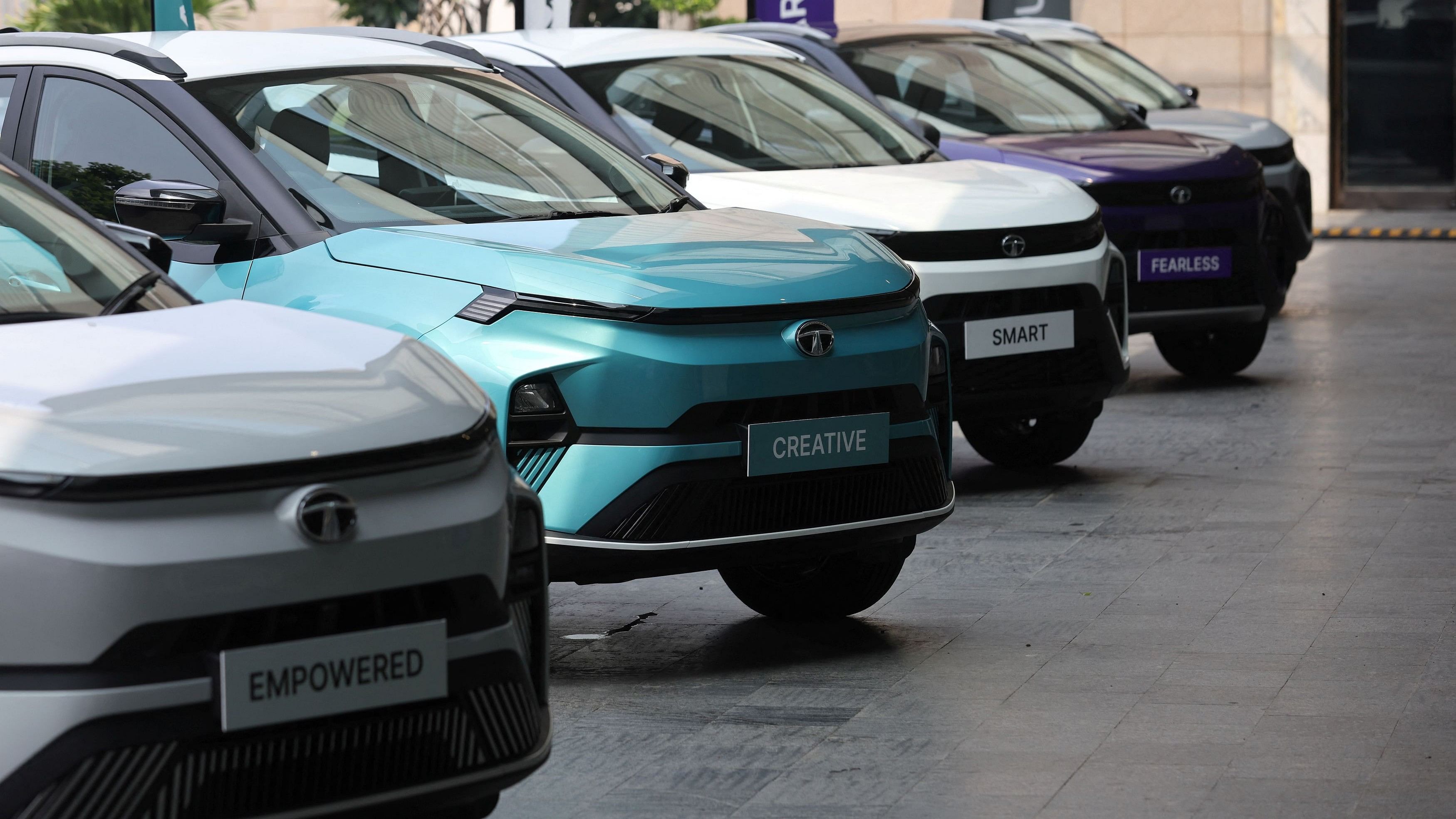
Tata Motors' Nexon and Nexon.ev cars are seen parked for display outside a hotel ahead of its launch in New Delhi, September 14, 2023.
Credit: Reuters File Photo
The automotive industry in India has undergone significant growth, emerging as a key contributor to the economy. With a rise in GDP contribution to 7.1 per cent in 2022-2023 from 2.77 per cent in 1992-1993, India has become a preferred global destination for automotive manufacturing. Looking ahead, significant transformations are anticipated in the global automotive industry over the next decade. Leveraging its IT capabilities, India is poised to ascend to the position of the world's third-largest automotive market by 2030.
The bold ‘EV’ promise
According to the Economic Survey 2023, India's domestic EV market is projected to grow at a compound annual rate of 49 per cent between 2022 and 2030, aiming for 10 million annual sales by 2030. EVs are anticipated to capture over 40 per cent of India's automotive market, generating over $100 billion of revenue by 2030.
Seizing the opportunity
India stands to create a multi-billion-dollar EV industry, achieve energy independence, and enhance air quality. Governments, at both the central and state levels, have been incentivising sustainable mobility, particularly in manufacturing and public charging infrastructure.
However, numerous structural challenges persist for a large-scale transition:
Promote R&D: Enhancements in battery and charging technology play a pivotal role in the growth and sustainability of the EV sector. Allocating funds towards research and development endeavours (in areas of battery technology, lightweight materials, and electric drivetrains) can lead to technological improvements in EVs, cost reduction, and extended vehicle range.
Decentralised Power Generation: The current power infrastructure in India might lack the capacity needed to facilitate a widespread shift to EVs. Encouraging the installation of rooftop solar panels and the development of community-based microgrids powered by renewable sources can alleviate some of these challenges. However, significant investments are necessary to modernise the grid infrastructure, enabling seamless integration and effective management of decentralised renewable energy sources.
Implement Carbon Exchange Programme: Introduce a platform for trading carbon credits or allowances, facilitating compliance with regulatory emissions targets or voluntary emission reduction commitments. Provide carbon credits or offsets to individuals, businesses, or local authorities embracing EV adoption or investing in EV infrastructure.
Encourage Fleet Electrification: Capitalise on the economic advantages driving the adoption of commercial EVs. Governments can offer incentives such as grants, subsidies, or mandates to fleet operators to switch to electric vehicles. Industries can design electric fleet solutions customised for various purposes, including delivery vans, taxis, buses, and ride-sharing services, catering to the rising need for emission-free transportation.
Enhance Supply Chain Integration: Bolstering the EV supply chain and improving domestic manufacturing capabilities are crucial for scaling up EV production and minimising reliance on imported components. The industry should prioritise investments in supply chain optimisation, forge strategic partnerships with suppliers, and pursue vertical integration to establish a robust and sustainable EV supply chain.
Policy and Framework: It is imperative to develop clear and comprehensive policies and regulations encompassing various aspects; like, setting emission standards with defined timelines for the gradual phase-out of polluting vehicles; standardising EV certification, charging infrastructure, and battery recycling protocols, and; implementing mechanisms to manage grid congestion and peak demand efficiently.
Inspiration from global initiatives
Various governments worldwide have implemented diverse policies and programmes to encourage the adoption of EVs and expedite the transition to sustainable transportation. EVs are poised to dominate the automotive landscape, as evidenced by automakers' investments nearing $1 trillion by 2030.
Here are some notable examples:
China: Through generous government subsidies, tax incentives, procurement contracts, and other policy measures, China has fostered the emergence of numerous domestic EV brands. With investments exceeding $60 billion, China is ambitiously aiming for a transition to all-electric or hybrid vehicles by 2035. Notably, over half of the EVs globally are found on Chinese roads, with new EV sales in 2022 growing by 82 per cent, and China accounting for 35 per cent of global EV exports.
United States: The US is channelling investments into EVs to reduce reliance on fossil fuels, combat Climate Change, create jobs in the clean energy sector, and drive innovation in sustainable transportation technologies. With investments totalling $165.1 billion, the US is focusing on manufacturing EVs, EV components, batteries, and promoting EV battery recycling.
In conclusion, India's venture into EVs offers vast prospects for economic expansion, energy autonomy, and ecological sustainability. Yet, confronting prevailing hurdles and enacting inclusive policies are imperative to unlock the complete potential of EVs within India's automotive domain.
(This is the second in a two-part series looking into the current state and challenges before India’s EV sector. To read the first article, click here.)
(Mohanakrishnan P is Chief Growth Officer, and Akshay Sasikumar is CEO, 82Volt Technologies.)
Disclaimer: The views expressed above are the author's own. They do not necessarily reflect the views of DH.